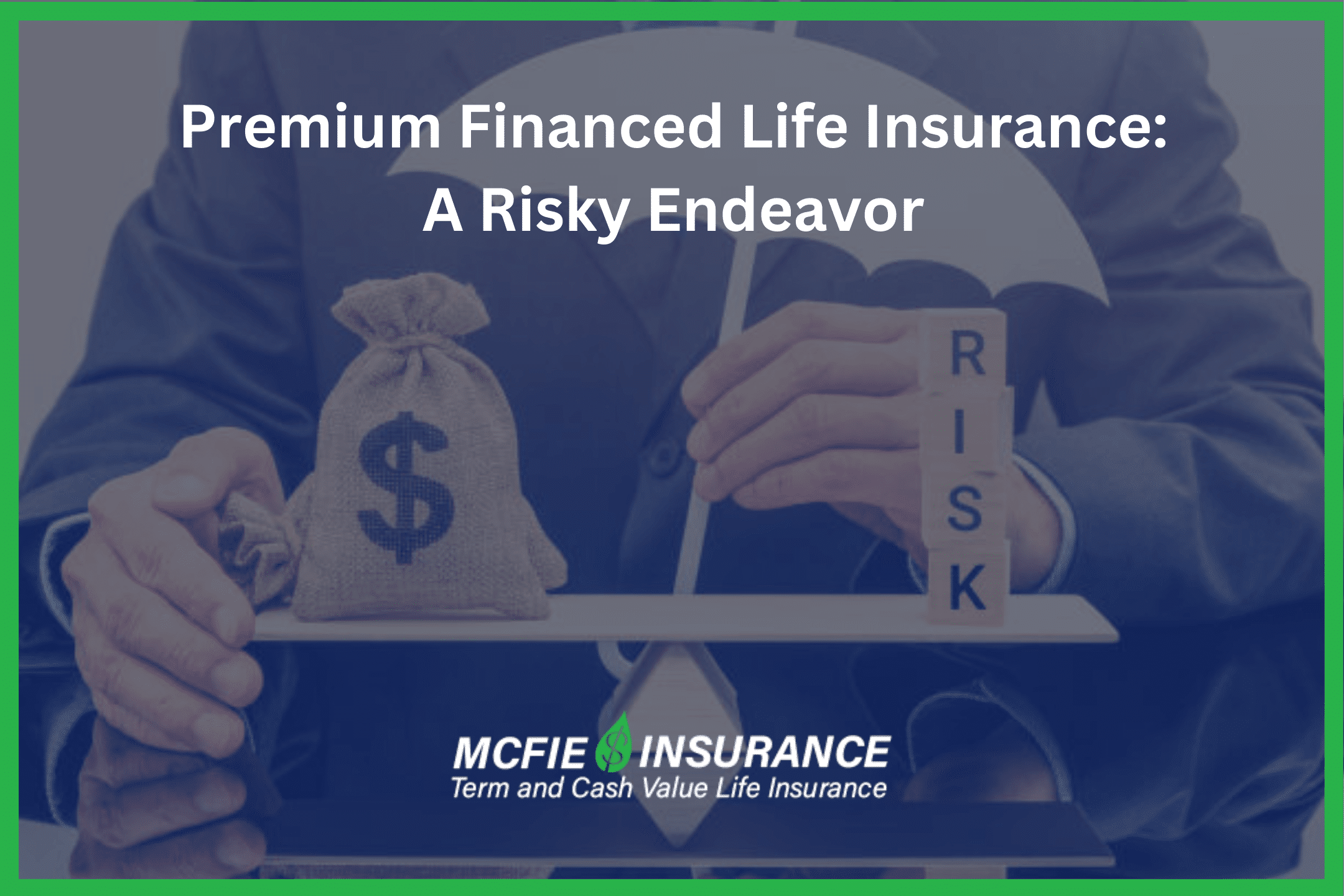702-660-7000
702-660-7000

It seems that premium financing to purchase life insurance is a common marketing tool to sell more life insurance to business owners and private individuals. Whether the marketing strategy is focused on how you can borrow against a life insurance policy you already own to finance another life insurance policy premium, or the marketing encourages you to use typical third-party financing, there are dangers that you should be aware of that could cost you a lot of money and other hardships.
Premium financing is a strategy used primarily by high-net-worth individuals to acquire large life insurance policies without having to liquidate their own assets to pay the premiums. At its core, premium financing involves borrowing money from a third-party lender—usually a bank or financial institution—to cover the cost of life insurance premiums. In exchange, the policyholder agrees to repay the loan, along with accrued interest, at a future date.
This setup can seem appealing, especially when someone wants to preserve their capital for other investments or maintain liquidity. But it’s important to understand how the structure works in practice. The lender is usually secured by the cash value of the policy. If the cash value isn’t sufficient to cover the outstanding loan balance—especially in the early years of the policy or during periods of low interest rate performance—the policyholder might be required to pledge additional collateral. This might involve other assets like securities, real estate, or personal guarantees.
If the insured person passes away before the loan is repaid, the lender is first in line to collect what’s owed from the policy’s death benefit. Only after the loan is paid in full will any remaining proceeds go to the beneficiaries. That can reduce the amount of money your loved ones receive, depending on the size of the loan and how long it’s been accruing interest.
While premium financing can be a useful tool in certain financial planning strategies—like estate planning or business succession planning—it carries real risks. Interest rate changes, policy underperformance, or mismanagement of the collateral can create financial strain. It’s not a one-size-fits-all solution, and it definitely isn’t for everyone.
That’s why anyone considering premium financing needs to understand the mechanics, assess the risks, and work with professionals who aren’t just looking to sell a policy, but who are committed to designing a plan that aligns with long-term goals.
Premium financing is a strategy most commonly utilized by affluent individuals—those with a net worth of $20 million or more—who need significant, long-term life insurance coverage. These individuals have complex financial portfolios, with the majority of their wealth tied up in businesses, investments, or illiquid assets like real estate. While they have the means to pay large premiums, doing so out of pocket might require selling off high-performing assets or disrupting other financial strategies. That’s where premium financing enters the picture.
Instead of using their own cash, these individuals borrow the funds needed to pay the premiums, allowing them to preserve their investment capital and continue benefiting from returns that often outpace the interest charged on the loan. In this way, premium financing serves as a leverage tool—freeing up capital for other opportunities while still securing a large death benefit that can support estate planning goals, provide liquidity for heirs, or protect a business interest.
For many wealthy individuals, this strategy is about optimizing opportunity cost. If their current investments are yielding, say, 8% annually, and the interest rate on the premium financing loan is 5%, they’re effectively gaining 3% by keeping their money working elsewhere. Over time, that spread can represent a large financial advantage.
That said, premium financing isn’t a plug-and-play solution. It involves long-term commitments, complex legal and financial structuring, and a careful analysis of collateral requirements. If the cash value of the policy doesn’t keep pace with the loan, or if interest rates rise unexpectedly, the borrower may need to post additional collateral or face a higher cost of capital. This is why premium financing is generally reserved for those with both the financial strength and the strategic discipline to manage it properly.
Used wisely, premium financing can be a powerful planning tool. But like any form of leverage, it magnifies outcomes—both good and bad. That’s why a well-designed premium financing strategy must be built on a foundation of conservative assumptions, professional guidance, and a long-term vision.
 |
Get a working knowledge of how each type of life insurance policy works. After reading this 10-page booklet you'll know more about life insurance than most insurance agents. Download here> |
T. Boone Pickens, oil tycoon, corporate raider, billionaire, and philanthropist died September 11, 2019. He was known for his attempted hostile take-overs of publicly traded companies that were top heavy, meaning that executives were taking most of the profits for themselves instead of paying higher dividends to their stockholders.
Pickens was also known for the Gift of a Lifetime arrangement that fell flat on its face when the market crashed in 2008, leaving an example from which all of us can benefit: Premium Financed Life Insurance is sketchy, speculative, and should be avoided.
Pickens encouraged his alma mater to borrow $16 million from a bank in Stillwater Oklahoma, in order to purchase life insurance on him and a few other Oklahoma State University alumni who were all over age 65. Now OSU could have paid those premiums with invested funds in Pickens hedge fund BP Capital. But BP Capital was providing a 30% rate of return on OSU’s invested funds and they didn’t want to lose that rate of return. Eventually they paid $33 million in premiums, all in borrowed money, before the bottom fell out.
One reason the bottom fell out was that none of the insured alumni died soon enough. Then the market collapsed and OSU lost $282 million over just 4 months. Then Bank of America made a margin call on OSU’s line of credit they had in order to build their football stadium and athletic department. This forced OSU to liquidate their BP Capital investments to pay off their Bank of America loan. Then another premium for $16 million came due which OSU had to borrow from the Stillwater bank to pay the life insurance company.
The long story made short is that OSU lost a lot of money because they could no longer continue to pay the life insurance premiums and they couldn’t afford to pay back the Stillwater bank for the money they had borrowed to finance the premiums already paid. In the end, they lost the policies. But the good ending to the story is that T. Boone Pickens picked up the tab on the loan from the Stillwater bank and paid it off for OSU at $3 million per quarter.
When Pickens passed away, his life insurance policy reimbursed his estate for all of those $3 million loan repayments made to that Stillwater bank, plus more.
That is the take home message.
Unless you have the kind of deep-pocketed connections or a solid financial foundation like T. Boone Pickens, borrowing money to finance life insurance policy premiums is not a strategy you should undertake lightly. Pickens, a savvy businessman, had the financial resources to cover not only his own obligations but also a $100 million life insurance policy on his life. In his case, the Stillwater bank and the coverage on his life were both secure, providing him with a well-calculated financial cushion. But let’s be real—this kind of financial setup is not something most business owners or private individuals have access to.
For the majority of people, premium financing can be a risky proposition. Unless you’re able to afford the policy premiums outright and have a solid safety net in place, relying on borrowed funds to cover your premiums can expose you to unforeseen financial risks. If things don’t go as planned, you could find yourself struggling to meet loan obligations, jeopardizing your financial future and your legacy.
Instead of getting caught up in complex premium financing arrangements, it’s far wiser to make sure that you’re covering your own back with permanent Whole Life insurance. While you might not need a policy of the same magnitude that Pickens left behind, whole life insurance offers a reliable foundation that builds cash value over time and provides a guaranteed death benefit.
Whole Life insurance secures your family’s financial future and offers the opportunity to leave behind a legacy of your own, whether it’s a business, a charitable donation, or simply the peace of mind knowing that your loved ones are financially supported. The key is to focus on what you can sustainably manage and build wealth the old-fashioned way—through steady contributions to a permanent life insurance policy that stands the test of time.
 Tomas P. McFie DC PhD
Tomas P. McFie DC PhD
Tom McFie is the founder of McFie Insurance and co-host of the WealthTalks podcast which helps people keep more of the money they make, so they can have financial peace of mind. He has reviewed 1000s of whole life insurance policies and has practiced the Infinite Banking Concept for nearly 20 years, making him one of the foremost experts on achieving financial peace of mind. His latest book, A Biblical Guide to Personal Finance, can be purchased here.